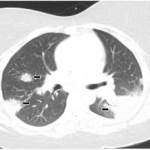She didn’t see her husband reach up with his free hand and wipe his eyes. In his years as a surgeon, he’d seen his share of tough, hopeless cases. But those patients had a terminal diagnosis; they were dying from advanced cancer or virulent infections or tragic accidents. But this?
As she pivoted to sit on the commode, she shut her eyes. It was coming back. She began to shiver. A drenching icy sweat soaked her nightgown. The wrenching pain filled every muscle, every joint, every fiber of her being.
At that moment, I walked through the door with an internal medicine resident and two medical students in tow.
Mrs. N. looked directly at me, then at her husband. “I’m tired,” she repeated softly, almost inaudibly. I helped her back to bed and sat down to think. Her nurse stuck a thermometer in her mouth. “103.6º.” She entered the data into the bedside computer and handed Mrs. N two Tylenol.
Momentarily, I said nothing. The “team” awkwardly shook Dr. N’s hand while we waited for the rigors to dissipate. One of the medical students did a lovely thing; she reached over and slowly massaged Mrs. N’s neck and shoulders.
Then I pulled the white sheet of paper out of my pocket, my cheat sheet of differential diagnoses—my Rosetta Stone of diagnostic possibilities. “I have a few ideas,” I said with as much optimism as I could muster. “Let’s get started.”
An Answer Presents
“I’ve called hematology. Dr. Ebraham has set aside time tomorrow morning to perform a bone marrow test.” I adjusted my glasses. What was this? The fourth time I’d suggested steroids? “For now, I want to start a modest intravenous dose of Solu-Medrol.” I paused. “I think it will help,” I added. “It’s time.”
Her eyes remained half-closed. The covers on her bed were strewn to the side, her arms, legs and core shaking uncontrollably, as if she were possessed. She had withdrawn to that internal place where she could just barely manage the suffering. “Fine,” she replied.
There is no single conclusive test to confirm adult-onset Still’s disease. The daily fevers & intense muscle and joint pain certainly fit the bill, as did the dramatically elevated inflammatory markers—the sedimentation rate and C-reactive protein. But patients with Still’s disease also demonstrate an evanescent salmon-colored rash with the daily fevers.
I nodded to the resident, who typed in the Solu-Medrol orders. “Let’s get that first dose hung up as soon as possible,” I whispered. Although we had other patients to round on, our small group stood transfixed by the violence of her illness. In another time, perhaps, a priest would have suggested an exorcism.


